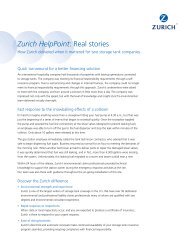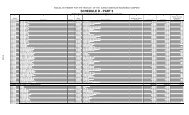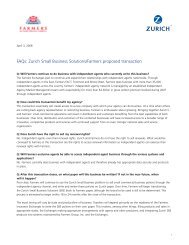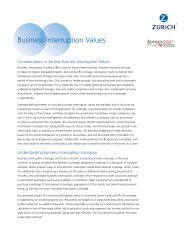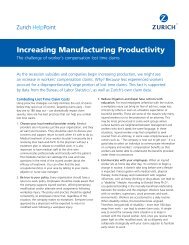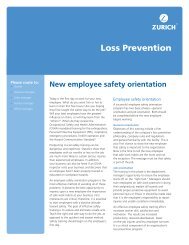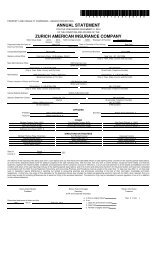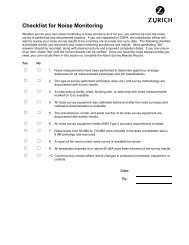Know the risks - Zurich
Know the risks - Zurich
Know the risks - Zurich
You also want an ePaper? Increase the reach of your titles
YUMPU automatically turns print PDFs into web optimized ePapers that Google loves.
• An institution may be insolvent or o<strong>the</strong>rwise unable to make indemnification.• Existing and proposed federal regulations may restrict indemnification. Forexample, under <strong>the</strong> current regulations of <strong>the</strong> Comptroller of <strong>the</strong> Currency,indemnification for civil money penalties is prohibited.Directors’ & officers’ liability insuranceD&O liability insurance provides a substantial measure of protection against <strong>the</strong>gaps in corporate indemnification, including coverage for most judgments andsettlements in derivative actions and protection when <strong>the</strong> institution is not permittedor financially unable to indemnify its directors. This section will briefly describe D&Oinsurance policies and <strong>the</strong> protections <strong>the</strong>y generally offer.D&O policies issued by different insurance companies differ widely in <strong>the</strong>ir coverage.In most cases, directors should ensure that a qualified broker, counsel, risk manageror o<strong>the</strong>r expert is involved to critique <strong>the</strong>ir D&O insurance program and assist inimproving <strong>the</strong> protection afforded by that program.“Most D&O policies offer atleast two forms of coverage.The first, referred to as <strong>the</strong>personal, direct, or “Side-A”coverage, provides coverage forclaims made against individualdirectors and officers for lossesthat are not indemnified by <strong>the</strong>company. The second form ofcoverage, referred to as <strong>the</strong>corporate reimbursement, or“Side-B” coverage, providesreimbursement for sums<strong>the</strong> company incurs in itsindemnification of loss incurredby <strong>the</strong> directors and officers.”1. Basic features of D&O policiesD&O policies are “claims made” policies, which means that <strong>the</strong>y cover claims firstmade during <strong>the</strong> policy period, whe<strong>the</strong>r <strong>the</strong> alleged wrongdoing occurred during orbefore <strong>the</strong> policy period. Therefore, it is important for corporations to maintain highqualityD&O policies for many years after a director’s or officer’s service ends, as coveragefor <strong>the</strong> former director or officer will be determined based on <strong>the</strong> policy in existencewhen <strong>the</strong> subsequent claim is made, and not when <strong>the</strong> alleged wrongdoing occurred.Most D&O policies offer at least two forms of coverage. The first, referred to as <strong>the</strong>personal, direct, or “Side-A” coverage, provides coverage for claims made againstindividual directors and officers for losses that are not indemnified by <strong>the</strong> company.The second form of coverage, referred to as <strong>the</strong> corporate reimbursement, or “Side-B”coverage, provides reimbursement for sums <strong>the</strong> company incurs in its indemnificationof loss incurred by <strong>the</strong> directors and officers. Both forms of coverage apply only to lossincurred by <strong>the</strong> directors and officers in claims made against <strong>the</strong> directors and officers.Although both types of coverage are contained in <strong>the</strong> same insurance policy, each willbe set forth in a separate insuring clause and each will be subject to different retentions,and perhaps exclusions.Many D&O policies can also cover <strong>the</strong> institution’s liability to third parties in connectionwith certain types of claims against it for its own alleged misconduct. Unless a D&Opolicy explicitly covers <strong>the</strong> institution’s liability to third parties, an institution will notbe entitled to coverage under its D&O policy, except with respect to its obligation toindemnify its directors and officers.2. Self-insured amounts and policy limitsNormally, a D&O policy will include a retention (<strong>the</strong> amount <strong>the</strong> insureds must paybefore <strong>the</strong> insurer’s obligations attach) under <strong>the</strong> Company Reimbursement (Side-B)coverage for loss <strong>the</strong> institution is required or permitted to pay as indemnification.A different self-insured retention may apply with respect to <strong>the</strong> institution’s ownliability to third parties, or to o<strong>the</strong>r specific types of claims. Typically, D&O insurers do26Financial institutions guide



